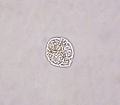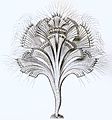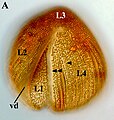Cercozoa
| Cercozoa | |
|---|---|

| |
| Cercomonas | |
| Scientific classification | |
| Domain: | Eukaryota |
| Clade: | Diaphoretickes |
| Clade: | SAR |
| Clade: | Rhizaria |
| Phylum: | Cercozoa Cavalier-Smith,1998[1]emend. Adl et al., 2005 emend. Cavalier-Smith, 2018[2] |
| Classes | |
| Synonyms | |
Cercozoa(now synonymised withFilosa)[2]is a phylum of diverse single-celledeukaryotes.[4][5]They lack shared morphological characteristics at the microscopic level,[6]and are instead united bymolecular phylogeniesofrRNAandactinorpolyubiquitin.[7]They were the first majoreukaryoticgroup to be recognized mainly throughmolecular phylogenies.[8]They are the natural predators of many species of bacteria. They are closely related to the phylumRetaria,comprising amoeboids that usually have complex shells, and together form a supergroup calledRhizaria.[2]
Characteristics[edit]
The group includes mostamoeboidsandflagellatesthat feed by means of filose pseudopods. These may be restricted to part of the cell surface, but there is never a truecytostomeor mouth as found in many other protozoa. They show a variety of forms[9]and have proven difficult to define in terms of structural characteristics, although their unity is strongly supported byphylogeneticstudies.
Diversity[edit]
Some cercozoans are grouped by whether they are "filose" or "reticulose" in the behavior of theircytoskeletonwhen moving:[10]
- Filose, meaning theirpseudopodsdevelop asfilopodia.For example:
- Euglyphids,filose amoebae with shells ofsiliceousscales or plates, which are commonly found in soils, nutrient-rich waters, and on aquatic plants.
- Gromia,a shelled amoeba.
- Tectofilosids,filose amoebae that produce organic shells.
- Cercomonads,common soil-dwelling amoeboflagellates.
- Reticulose, meaning they form a reticulating net ofpseudopods.For example:
- Chlorarachniophytes,set apart by the presence ofchloroplastsbound by four membranes and still possess a vestigial nucleus, called a nucleomorph. As such, they have been of great interest to researchers studying the endosymbiotic origins of organelles.
Other important ecological groups are:
- Granofilosea,comprising several groups traditionally consideredheliozoasuch asHeliomonadida,DesmothoracidaandGymnosphaerida.[10]
- Phaeodaria,marine protozoa previously consideredradiolarians.[11]
Ecology[edit]
As well as being highly diverse inmorphologyandphysiology,Cercozoa also shows highecological diversity.[12]The phylum Cercozoa includes many of the most abundant and ecologically significantprotozoainsoil,marineandfreshwaterecosystems.[8]
Soil-dwelling cercozoans are one of the dominant groups of free-living eukaryotic microorganisms found intemperatesoils, accounting for around 30% of identifiable protozoanDNAin arid or semi-arid soils and 15% in more humid soils. Intranscriptomicanalyses they account for 40-60% of all identifiable protozoanRNAfound in forest and grassland soils. They also comprise 9-24% of alloperational taxonomic unitsfound in theocean floor.[12]
Some cercozoa are coprophilic orcoprozoic,meaning they usefecesas a source ofnutrientsor as transport through animal hosts. The faecal habitat is an understudied reservoir of microbial eukaryotic diversity, dominated by amoeboflagellates from the phylum Cercozoa. Strongly coprophilic examples of cercozoa are the flagellatesCercomonas,ProleptomonasandHelkesimastix,and thesorocarpicamoebaGuttulinopsis.Many new cercozoan lineages, especially amongsarcomonads,have been discovered through phylogenetic sampling of feces because they appear preferentially in this medium.[13]
Cercozoanbacterivores(i.e.predatorsofbacteria) are highly diverse and important in the plantphyllosphere,the leaf surfaces of plants. Particularlysarcomonads,with their ability tocyst,feed and multiply within hours, are perfectly adapted to the fluctuating environmental factors in the phyllosphere. Their predation causes shifts in the bacterial communities: they reduce populations ofalphaproteobacteriaandbetaproteobacteria,which are less resistant to their grazing, in favour of other bacterial populations such asgammaproteobacteria.[14]
Evolution[edit]
External evolution[edit]
| Paraphyletic Cercozoa[2] |
| Monophyletic Cercozoa[15] |
Originally, Cercozoa contained both Filosa andEndomyxa,according tophylogeneticanalyses usingribosomal RNAandtubulin.These analyses also confirmed Cercozoa as the sister group of Retaria within the supergroup Rhizaria.[10][16]
However, themonophylyof the group was still uncertain. Posterior multigene phylogenetic analyses consistently found Cercozoa to be paraphyletic, becauseEndomyxaclustered next toRetariainstead of Filosa.[17][18][19]Because of this, Endomyxa was excluded from Cercozoa, which became a synonym of Filosa.[2]
More recent phylogenomic analyses with better sampling recovered a sister relationship between Filosa (=Cercozoa) andEndomyxaonce again,[15]although the modern classification of eukaryotes retainsEndomyxa,Cercozoa andRetariaas separate phyla withinRhizaria.[20]
Internal evolution[edit]
The phylum Cercozoa previously contained both Filosa andEndomyxa,but in the latest classifications Endomyxa has been excluded, and Cercozoa is now synonymous with Filosa. It is composed of twosubphyla:MonadofilosaandReticulofilosa.According to multigenephylogeneticanalyses, Monadofilosa is a robustclade,in which the deepest branching group isMetromonadea,followed byHelkeseaas the second group (together forming the paraphyleticEoglissa) before the divergence of the cladeVentrifilosa(Imbricatea,SarcomonadeaandThecofilosea). On the other hand, Reticulofilosa is probably paraphyletic, withGranofiloseadiverging earlier thanChlorarachnea,which makes Chlorarachnea the sister group of Monadofilosa.[2]
| Cercozoa | |
A more recentphylogenomicanalysis recovered both Monadofilosa and Reticulofilosa as monophyletic within the clade Filosa.[15]
In addition to the knownGranofilosea,ChlorarachneaandMonadofilosa,a variety ofcladesinside Cercozoa have been discovered in other analyses and have slowly been described and named, such asTremulida(previously known as Novel Clade 11)[16]andAquavolonida(Novel Clade 10),[21]although their specific positions among the two main cercozoan subphyla have yet to be refined. These two orders have been classified as the classSkiomonadea,within Reticulofilosa.[2]
Classification[edit]
The classification of Cercozoa was revised in 2018:[2]
- SubphylumReticulofilosaCavalier-Smith 1997
- ClassChlorarachneaHibberd & Norris 1984 (asChlorarachniophyceae)
- ClassGranofiloseaCavalier-Smith & Bass 2009
- ClassSkiomonadeaCavalier-Smith 2012
- SubphylumMonadofilosaCavalier-Smith 1997
- SuperclassEoglissaCavalier-Smith 2011 emend. 2018
- ClassMetromonadeaCavalier-Smith 2007
- ClassHelkeseaCavalier-Smith 2018
- SuperclassVentrifilosaCavalier-Smith 2012 emend. 2018
- ClassSarcomonadeaCavalier-Smith 1993 emend. 2018
- ClassImbricateaCavalier-Smith 2003 emend. 2018
- ClassThecofiloseaCavalier-Smith 2003 emend. 2012
- SuperclassEoglissaCavalier-Smith 2011 emend. 2018
Gallery[edit]
-
Cercomonassp. (Cercozoa:Cercomonadida)
-
Ebriasp. (Cercozoa:Ebridea)
-
Rhipidodendronsp. (Cercozoa:Spongomonadea)
-
Euglyphasp. (Cercozoa:Euglyphida)
-
Phaeodarians (Cercozoa:Phaeodarea)
-
Clathrulina elegans(Cercozoa:Desmothoracida)
-
Chlorarachnionsp. (Cercozoa: (Chlorarachniophyta)
-
Vampyrellasp. (Cercozoa:Vampyrellidae)
-
Auranticordis(Cercozoa:Marimonadida)
References[edit]
- ^Cavalier-Smith, T. (1998). "A revised six-kingdom system of life".Biological Reviews of the Cambridge Philosophical Society.73(3): 203–266.doi:10.1111/j.1469-185X.1998.tb00030.x.PMID9809012.S2CID6557779.
- ^abcdefghCavalier-Smith, Thomas; E. Chao, Ema; Lewis, Rhodri (2018), "Multigene phylogeny and cell evolution of chromist infrakingdom Rhizaria: contrasting cell organisation of sister phyla Cercozoa and Retaria",Protoplasma,255(5): 1517–1574,doi:10.1007/s00709-018-1241-1,PMC6133090,PMID29666938
- ^Cavalier-Smith T (1997)."Amoeboflagellates and mitochondrial cristae in eukaryote evolution: megasystematics of the new protozoan subkingdoms eozoa and neozoa".Archiv für Protistenkunde.147(3–4): 237–258.doi:10.1016/S0003-9365(97)80051-6.ISSN0003-9365.
- ^Nikolaev SI, Berney C, Fahrni JF, et al. (May 2004)."The twilight of Heliozoa and rise of Rhizaria, an emerging supergroup of amoeboid eukaryotes".Proc. Natl. Acad. Sci. U.S.A.101(21): 8066–71.doi:10.1073/pnas.0308602101.PMC419558.PMID15148395.
- ^Hoppenrath, M.; Leander B.S. (2006). "Ebriid phylogeny and the expansion of the Cercozoa".Protist.157(3): 279–90.doi:10.1016/j.protis.2006.03.002.PMID16730229.
- ^Chantangsi, C. (2009).Comparative morphology and molecular evolution of marine interstitial cercozoans.PhD thesis. University of British Columbia.
- ^"SYSTEMATIC BIOLOGY: CERCOZOA".Archived fromthe originalon 2015-04-02.Retrieved2009-03-28.
- ^abBass D, Cavalier-Smith T (1 November 2004)."Phylum-specific environmental DNA analysis reveals remarkably high global biodiversity of Cercozoa (Protozoa)".International Journal of Systematic and Evolutionary Microbiology.54(6): 2393–2404.doi:10.1099/ijs.0.63229-0.PMID15545489.
- ^Cavalier-Smith T, Chao EE (October 2003)."Phylogeny and classification of phylum Cercozoa (Protozoa)"(PDF).Protist.154(3–4): 341–58.doi:10.1078/143446103322454112.PMID14658494.
- ^abcBass D, Chao EE, Nikolaev S, et al. (February 2009). "Phylogeny of Novel Naked Filose and Reticulose Cercozoa: Granofilosea cl. n. and Proteomyxidea Revised".Protist.160(1): 75–109.doi:10.1016/j.protis.2008.07.002.PMID18952499.
- ^Nakamura, Yasuhide; Imai, Ichiro; Yamaguchi, Atsushi; Tuji, Akihiro; Not, Fabrice; Suzuki, Noritoshi (2015)."Molecular Phylogeny of the Widely Distributed Marine Protists, Phaeodaria (Rhizaria, Cercozoa)".Protist.166(3): 363–373.doi:10.1016/j.protis.2015.05.004.PMID26083083.
- ^abHarder C, Rønn R, Brejnrod A, et al. (8 March 2016)."Local diversity of heathland Cercozoa explored by in-depth sequencing".The ISME Journal.10(10): 2488–2497.doi:10.1038/ismej.2016.31.PMC5030685.PMID26953604.
- ^Bass D, Silberman JD, Brown MW, Pearce RA, Tice AK, Jousset A, Geisen S, Hartikainen H (23 February 2016). "Coprophilic amoebae and flagellates, including Guttulinopsis, Rosculus and Helkesimastix, characterise a divergent and diverse rhizarian radiation and contribute to a large diversity of faecal-associated protists".Environmental Microbiology.18(5): 1604–1619.doi:10.1111/1462-2920.13235.PMID26914587.
- ^Flues S, Bass D, Bonkowski M (15 June 2017). "Grazing of leaf-associated Cercomonads (Protists: Rhizaria: Cercozoa) structures bacterial community composition and function".Environmental Microbiology.19(8): 3297–3309.doi:10.1111/1462-2920.13824.PMID28618206.
- ^abcIrwin, Nicholas A.T.; Tikhonenkov, Denis V.; Hehenberger, Elisabeth; Mylnikov, Alexander P.; Burki, Fabien; Keeling, Patrick J. (2019-01-01). "Phylogenomics supports the monophyly of the Cercozoa".Molecular Phylogenetics and Evolution.130:416–423.doi:10.1016/j.ympev.2018.09.004.ISSN1055-7903.PMID30318266.S2CID52982396.
- ^abHowe, Alexis T.; Bass, David; Scoble, Josephine M.; Lewis, Rhodri; Vickerman, Keith; Arndt, Hartmut; Cavalier-Smith, Thomas (2011)."Novel Cultured Protists Identify Deep-branching Environmental DNA Clades of Cercozoa: New GeneraTremula,Micrometopion,Minimassisteria,Nudifila,Peregrinia".Protist.162(2): 332–372.doi:10.1016/j.protis.2010.10.002.ISSN1434-4610.PMID21295519.
- ^Burki F, Corradi N, Sierra R, Meyer GR, Abbott CL, Keeling PJ, et al. (July 2013)."Phylogenomics of the Intracellular ParasiteMikrocytos mackiniReveals Evidence for a Mitosome in Rhizaria ".Current Biology.23(16): 1541–1547.doi:10.1016/j.cub.2013.06.033.PMID23891116.S2CID8257631.
- ^Burki F, Kudryavtsev A, Matz MV, et al. (2010)."Evolution of Rhizaria: new insights from phylogenomic analysis of uncultivated protists".BMC Evol Biol.10:377.doi:10.1186/1471-2148-10-377.PMC3014934.PMID21126361.
- ^Krabberød, Anders K.; Orr, Russell J.S.; Bråte, Jon; Kristensen, Tom; Bjørklund, Kjell R.; Shalchian-Tabrizi, Kamran (2017)."Single Cell Transcriptomics, Mega-Phylogeny, and the Genetic Basis of Morphological Innovations in Rhizaria".Mol. Biol. Evol.34(7): 1557–1573.doi:10.1093/molbev/msx075.PMC5455982.PMID28333264.
- ^Adl SM, Bass D, Lane CE, Lukeš J, Schoch CL, Smirnov A, Agatha S, Berney C, Brown MW, Burki F, Cárdenas P, Čepička I, Chistyakova L, del Campo J, Dunthorn M, Edvardsen B, Eglit Y, Guillou L, Hampl V, Heiss AA, Hoppenrath M, James TY, Karnkowska A, Karpov S, Kim E, Kolisko M, Kudryavtsev A, Lahr DJG, Lara E, Le Gall L, Lynn DH, Mann DG, Massana R, Mitchell EAD, Morrow C, Park JS, Pawlowski JW, Powell MJ, Richter DJ, Rueckert S, Shadwick L, Shimano S, Spiegel FW, Torruella G, Youssef N, Zlatogursky V, Zhang Q (2019)."Revisions to the Classification, Nomenclature, and Diversity of Eukaryotes".Journal of Eukaryotic Microbiology.66(1): 4–119.doi:10.1111/jeu.12691.PMC6492006.PMID30257078.
- ^Bass D, Tikhonenkov DV, Foster R, Dyal P, Janouškovec J, Keeling PJ, Gardner M, Neuhauser S, Hartikainen H, Mylnikov AP, Berney C (2018)."Rhizarian 'Novel Clade 10' Revealed as Abundant and Diverse Planktonic and Terrestrial Flagellates, includingAquavolonn. gen ".Journal of Eukaryotic Microbiology.65(6): 828–842.doi:10.1111/jeu.12524.PMC6282753.PMID29658156.
External links[edit]
- Tree of LifeCercozoa
- phylogeny of Phaeodarea










